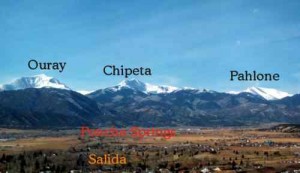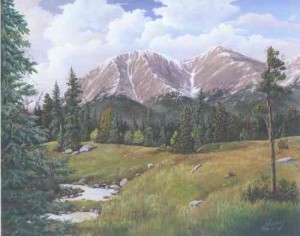Sidebar by Ed Quillen
Local Lore – December 2004 – Colorado Central Magazine
ANGELIC MOUNT SHAVANO isn’t the only peak in the Sawatch Range with a legend.
At the south end of the range near Marshall Pass is Mount Ouray, which just misses 14er status; it’s 13,971 feet high. On its east side is an immense glacial cirque or cwm (pronounced koom; it comes from Welsh and it can be a handy word in a Scrabble game).
One bit of local lore has it that the cwm is the throne of Chief Ouray, and that if he gets sufficiently angered by the actions of the folks in the valley below, especially in how they care for the land they took from his people, he will rise from that throne and smite them.
Moving on north, there are the Chalk Cliffs over Chalk Creek at the foot of Mount Princeton. Actually, they’re not made of chalk, but of crumbling white quartz monzonite that looks like chalk. (To mineralogists, chalk is calcium carbonate, CaCO3, and the stuff used on blackboards comes from calcium sulfate, CaSO4, but the stuff the Chalk Cliffs are made of isn’t usually called chalk at all.)
According to A Climbing Guide to Colorado’s Fourteeners, the Mt. Princeton Chalk Cliffs legend goes like this: In about 1780, “a small group of Spaniards from settlements in New Mexico raided an Indian village and escaped with a large amount of valuable items. The Indians quickly pursued the thieves, and the Spaniards were forced to stash the treasure somewhere in the Chalk Cliffs.”
This treasure has never been found (or if it has been, the finder had the good sense to keep his mouth shut). Because the cliffs are formed from rotten, unstable rock, searching for treasure there is quite dangerous. Besides, in terms of treasure it seems more logical to look for gold shipments or pirate booty than for this legendary fare — because you’ve got to wonder how much treasure there would have been in the average Indian village. However, it is nice to remember that someday most everyone’s household items will be converted into precious museum pieces – even things like pop cans, refrigerator magnets, Darth Vader figurines, and even those ugly, double-breasted, brightly colored, polyester jackets from the ’70s.
But back to the legendary.
[1874 Holy Cross woodcut]
The northernmost 14er in the Sawatch Range must hold the record for legends. That’s no surprise, given its name: Mount of the Holy Cross.
The 14,005-foot peak sits in a rugged area, and nearby Notch Mountain blocks the view of the cross from many locations. Thus its very existence was a matter of legend for many years. Although mountain men and trappers claimed that they’d seen it, they weren’t quite sure where.
Finding it was one goal of the Hayden Survey of 1873, which resulted in William Henry Jackson’s famous photographs, taken from Notch Mountain on Aug. 23.
NOW FOR THE LEGENDS, which are recounted in Holy Cross – the Mountain and the City, by Robert L. Brown (out of print, but available in used-book markets).
Several tales attributed the discovery of Holy Cross to the Hernando De Soto expedition of 1539. They did wander from Tampa, Florida, to Vera Cruz (True Cross), Mexico, but that expedition never got anywhere near the Mount of the Holy Cross.
A related version has a Franciscan friar expelled from De Soto’s expedition who then murders a man and ventures into the wilderness to seek a sign of forgiveness – and eventually he sees a huge snowy cross. This account was made into a story that appeared in Redbook magazine in 1927.
Henry Wadsworth Longfellow’s long narrative poem Evangeline has been stretched to accommodate Holy Cross as part of the Arcadians’ forced migration from Nova Scotia to Louisiana in the 1750s, and their encounters with some mountains during their travels. But the text makes it clear that Longfellow was writing about the Ozarks, not the Rockies.
Longfellow did write about the peak, in an 1879 poem not published during his lifetime. His wife, Frances, had died in an 1861 fire, and 18 years later, the poet chanced across an engraving of the mountain, probably based on Jackson’s 1873 photographs. The picture, and Longfellow’s memories of a woman he still missed, inspired this poem:
In the long, sleepless watches of the night
A gentle face–the face of one long dead–
Looks at me from the wall, where round its head
The night lamp casts a halo of pale light.
Here in this room she died; and soul more white
Never through martyrdom of fire was led
To its repose; nor can in books be read
The legend of a life more benedight.
There is a mountain in the distant West
That, sun-defying, in its deep ravines
Displays a cross of snow upon its side.
Such is the cross I wear upon my breast
These eighteen years, through all the changing scenes
And seasons, changeless since the day she died.
That’s symbolism, however, not legend. But during the 1920s there were accounts of cures that resulted from handkerchiefs that had been dipped in the lake at the foot of the cross.
TODAY, ONE ARM of the cross doesn’t look as distinct as it did back then; a legend blames that on some soldiers who got ambitious during artillery practice at nearby Camp Hale during World War II, and fired a round at the cross. But there’s no record of that, and Robert Brown checked in every possible place when researching his book.
That’s a good start on the legends of Holy Cross. If you want to see the cross, the best view is from 13,257-foot Notch Mountain. By all accounts, it’s not an easy climb, but the view is worth it. The easiest view comes while descending the west side of Shrine Pass, an unpaved road which leaves I-70 just below the top of Vail Pass, and descends to Red Cliff. The pass got its name from the view it provides, and it’s a popular cross-country ski route.
Ed Quillen has seen Mount of the Holy Cross from Shrine Pass and from the Climax property.


